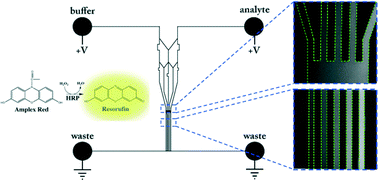Effects of molecular confinement and crowding on horseradish peroxidase kinetics using a nanofluidic gradient mixer†
Abstract
The effects of molecular confinement and crowding on enzyme kinetics were studied at length scales and under conditions similar to those found in biological cells. These experiments were carried out using a nanofluidic network of channels constituting a nanofluidic gradient mixer, providing the basis for measuring multiple experimental conditions simultaneously. The 100 nm × 40 μm nanochannels were wet etched directly into borosilicate glass, then annealed and characterized with fluorescein emission prior to kinetic measurements. The nanofluidic gradient mixer was then used to measure the kinetics of the conversion of the horseradish peroxidase (HRP)-catalyzed conversion of non-fluorescent Amplex Red (AR) to the fluorescent product resorufin in the presence of hydrogen peroxide (H2O2). The design of the gradient mixer allows reaction kinetics to be studied under multiple (five) unique solution compositions in a single experiment. To characterize the efficiency of the device the effects of confinement on HRP-catalyzed AR conversion kinetics were studied by varying the starting ratio of AR : H2O2. Equimolar concentrations of Amplex Red and H2O2 yielded the highest reaction rates followed by 2 : 1, 1 : 2, 5 : 1, and finally 1 : 5 [AR] : [H2O2]. Under all conditions, initial reaction velocities were decreased by excess H2O2. Crowding effects on kinetics were studied by increasing solution viscosity in the nanochannels in the range 1.0–1.6 cP with sucrose. Increasing the solution viscosities in these confined geometries decreases the initial reaction velocity at the highest concentration from 3.79 μM min−1 at 1.00 cP to 0.192 μM min−1 at 1.59 cP. Variations in reaction velocity are interpreted in the context of models for HRP catalysis and for molecular crowding.


 Please wait while we load your content...
Please wait while we load your content...